Anonymous Artist Interview
Author notes: - In 2013, I had the privilege of getting acquainted with one of the original WorldsAway artists. We had a brief but intense exchange regarding their time there and their career in general.
They were happy for me to repurpose our conversations into an interview format; however, they wish to remain totally anonymous and for nobody to contact them in the future. If you do manage to ascertain their identity from this interview, please respect their privacy. They were very generous with their time here and shared a lot of interesting anecdotes.
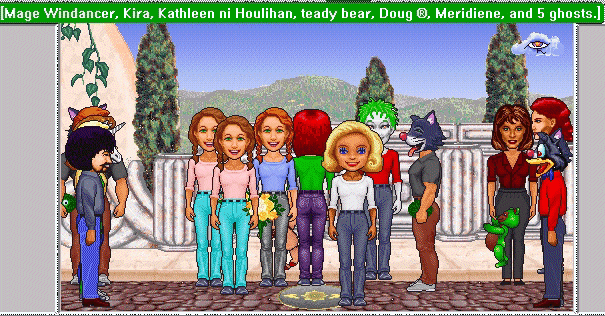
Artist: I did the "Athletic Male and Female" Avatar animations. They were - If I'm remembering rightly - mostly done in DPaint, in 5 colors because of palette restrictions. Torsos were a sprite independent of the limbs. Arms were 2 sprites: upper and lower; legs also upper and lower. Heads were separate. Sprites were mixed together to provide the necessary animation sets, to cut down on the unique parts. I remember running the animation and watching the torso and upper arm stay stationary while the lower arm/hand moved around, for example.
Also, the mostly modular nature allowed for new actions to be built with maybe just a new hand or lower arm, not the entire body.
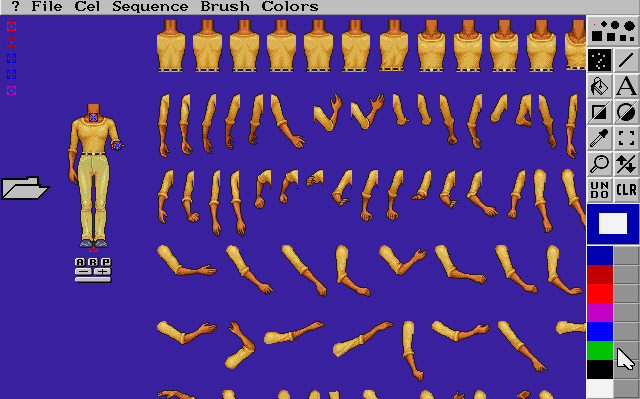
Like I said previously, I did the "Athletic Male" and "Athletic Female" WorldsAway bodies. Tarzan & Jane and Adam & Eve are different phenotypes. Tarzan & Jane are wearing minimal clothing (loincloth; bikini); Adam & Eve are nudes, meant for the future-planned 'adult-only' world, as well as the potential-future separate clothing. (Presuming that the technology would allow different clothing overlays), so - aside from the clothing, there's no real difference between the Tarzan & Jane and Adam & Eve bodies.
I spent a lot of time with Animax which was a tile editor created by a former Electronic Arts employee. It was begun as a tile editor for backgrounds originally. There were several artists doing backgrounds and animations, some in-house, some contractors.
I transferred some floppy disks that were used during development for the artist and on one of the disks, was a piece of artwork never seen before. Here, they explain what it was.
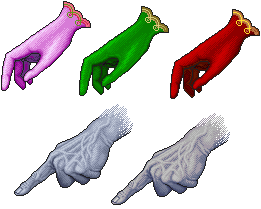
The "Godhand" was the pointing finger that came down from heaven which the Oracles used when a WorldsAway member did something wrong.
Author note: The God hand was never used inworld and doesn't appear to have been processed as usable artwork. Some animation frames of the God hand do exist though and will be made available on the image archive in the future. The God hand originated in Lucasfilm's Habitat and can be seen today over at the NeoHabitat Project.
Regarding the floppy disks I transferred.
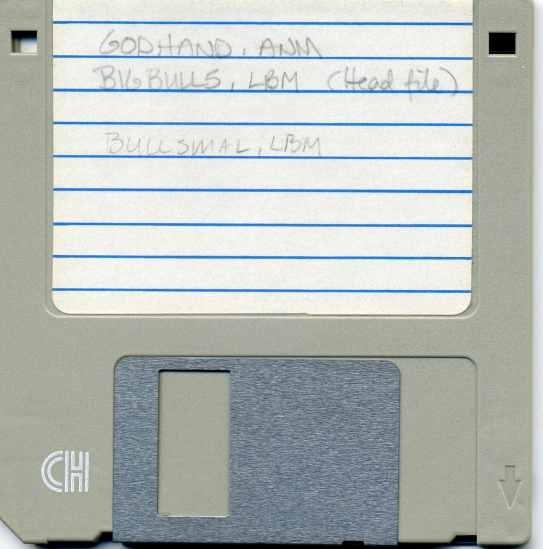
What kind of computer system did you run DPaint on back then when you used these disks? Amiga or PCs? The thought just occurred to me that Amiga based floppy disks need to be read using an actual Amiga or special hardware.
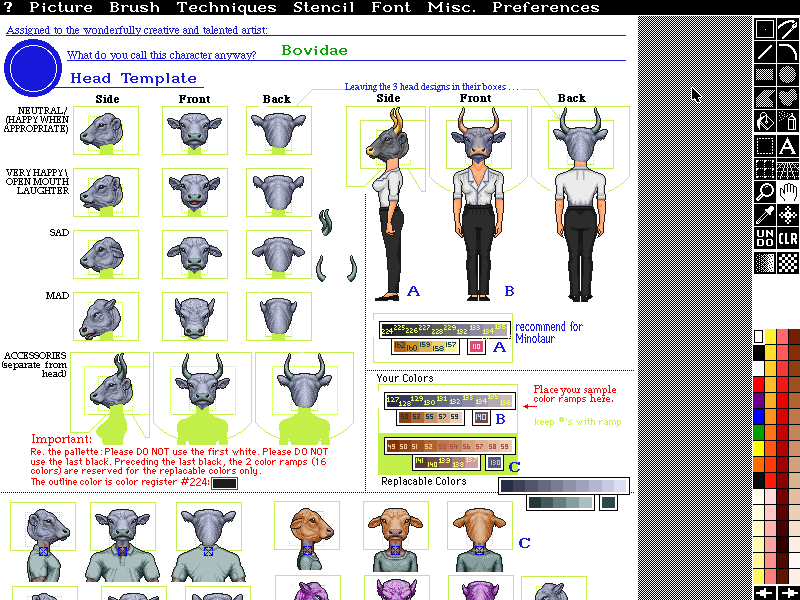
I used a DOS-PC. 286.
I believe a Sun UNIX workstation was used for some of the assembly (the old "pizza box")
Good thought; I'd forgotten about the Amiga stuff, even though I used to have one, and did do animations on the Amiga when i first started. But not for this, PC. You're safe.
Regarding the usage of only five colors, I find that quite shocking! They still hold up well regardless. It is quite amazing just to think how much time has passed since then and how far the industry has come. I can’t believe you didn’t really go inworld!
Who came up with the ideas for the themes of these original bodies? Did Fujitsu just request a set of male/female bodies? Or did they provide a brief for you to work with.
Did you have any future bodies planned after these six at all? Or was it all laid out in advance you'd only be doing them on a contractual basis as needed.
I thought you might not be aware of some of the limitations. Pretty much only people who actually worked with CGA, EGA palettes are the ones who realize that the modern color/memory availability was just not happening back then. My Amiga had *500K* of memory and I bought a separate memory-expansion card for another 500K. Woo! You kept your programs on floppy, not resident, and waited for them to load each time you used them.
The color limitations were not unusual at the time. Instead of multiple hues for shading, we used dithering and the checkerboard-effect blurred into a 'new' color, or at least softened the edge transitions between colors. Color space was allotted for different things on the palette. In addition to the system colors, there were colors assigned to sprites (moving objects), colors assigned to backgrounds, colors assigned to different characters. For the heads and clothing, when you purchased a spraycan to change color, you assigned different colors to that head/clothing.
Colors were literally NUMBERED on the palette, so if a head used colors 118 - 124, then changing the hues of spaces 118 - 124 would re-color the head. That's how it was done, not by adding 'additional' colors. It was a bit of a trial to get spraycan color sets put together as well. On my palette, the skin-tone colors were always in one place. Oh, and shades of gray (between white and black) were *always* on the palette.
I don't remember being much privy to planning and strategy of in-world stuff. I was a *contractor* not employee, and certainly not one of the planning-it-out types. Artist for hire. Fujitsu ran A LOT of contractors. It took time to do a set of bodies, and then get them programmed in and implemented. I don't think WorldsAway was planning on having a huge pile of different ones: there was both production and in-world management overhead. Each body needed its own database.
Fujitsu started having financial issues with WorldsAway, at least in the US, and support declined after a while. That set of artwork is the last I did for them before being "non-renewed" during their belt-tightening. I do believe there'd been a plan to open an adults-only world for higher subscription fees, but no idea what came about.
As a contractor, since ANY AND EVERY DAY COULD BE MY LAST DAY, I didn't invest a huge amount in the projected plans of the company. Come in, do the job assigned to the best of my ability, and don't bank on permanence. Not everyone can maintain the mindset for that.
And as far as never going in-world... well, I spent 8-10 hours working on it during the day, I didn't want to spend more time in it at home. We were encouraged to do so, but it wasn't a requirement. I had other stuff to do in real life, and that life - especially then- was pretty fulfilling. I didn't have much curiosity regarding the on-line world. I worked on it and that was enough for me. I've never really felt much need or desire to 'be someone else', no driving need to create a persona in a different world.
I was also contract at Electric Communities and spent even less time there. That project was just getting going. Their aspirations were high. I didn't enjoy the work there as well as at WorldsAway; the bar was set higher, but I was chastised for "taking too long". [ Please see comment regarding : "Can't pull art out of my butt" ] They wanted 3D style avatars in complex costumes and it takes TIME to generate the basics when there's no template to begin with, which is what I was hired to do. There were also a lot of start-up funkinesses going on, as it was a true start-up. I did make many friends there, and we're still friends, but that *world* I had even less involvement with. I have NO idea what happened to it.
Again, contractor mind-set. In, do the job, out.
It's interesting that Fujitsu had a lot of contractors. I guess it was easier to have a smaller inhouse team and just hire people as needed.
Fujitsu had MANY contractors. At one point they decided to cut costs and laid off all the contractors, only to find they'd lopped off all the Microsoft programmers, thus effectively killing their PC development. (Many contractors were hired back quickly!)
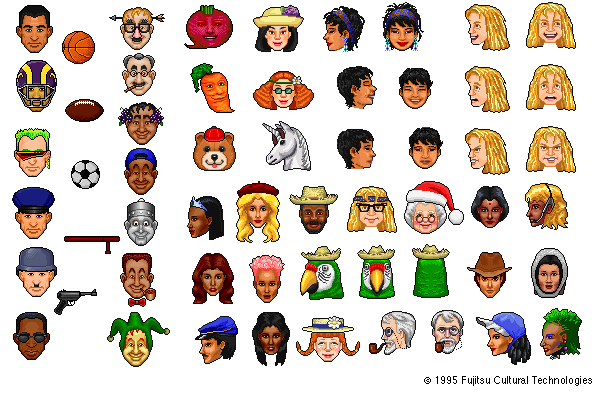
One of the good things about WorldsAway was the original focus on *heads* and not the bodies. Sheryl Knowles did the portly male, and the 'standard' female (wearing the cow head in your image). Heads were quite detailed and fanciful and colorful, so that was a good choice on the designers' part.
Can you tell us some more about Animax? You mentioned it was used for WorldsAway at some point.
I used Animax extensively working on a never-released game version of Lord of the Rings for EA. It was canned. There were politics. There were a lot of resources put on that game. This is where I was saying, many emails ago, that about 80% of my work never was released. The Animax programmer created "extra" colors in the palette by blurring colors from disparate palettes (don't ask me how it worked; essentially like using red-and-green to make brown, when the red was in one palette and the green in another). I made to scale maps of the world levels so we could plot character paths and game development on rolls of 1/4"-grid paper (no, I don't still have them. I DO still have just a few story boards from early days). This LOTR project suffered from massive mis-management; we had a new game producer about every 2 months. for a while. This was not a good thing.
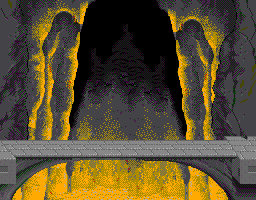
Honestly, there weren't all that many truly original ideas for console games. In fact, it was really easy to pitch a new title by saying "It's our version of but using as a different character." Accolade's "Bubsy" was a direct rip-off of Sonic, in the attempt to cash in on the popularity of Sonic. EVERYBODY had to have a Sonic-type game; a Mortal Kombat-type game; a Mario-type game... Then there were the sports games (football, baseball, etc) and a first-person-shooter. Seriously, I think there were only about 8 formulae.
Anyhoo... the Lord Of The Rings game was scrapped, but I did do a lot of work with Animax. It was a very very good tool for that kind of project. The Animax programmer & I tried to get Electric Communities to use Animax, but there was definitely a "not invented here" prejudice on that; I think it would've been advantageous if Electric Communities HAD used Animax, instead of trying to write their own editor. But that's definitely a story which has been repeated more than once
I came across this on your resume and meant to ask you about it:
Apr 1997 - Feb 1998: Fujitsu Software Corporation:
"My primary duties here were creating animations of 3D human-body "Avatars" using commercially available mesh models. This included refining texture maps and palette to conform to current product limitations, and testing mesh-mapping of current artwork for replaceable heads."
Did anything like this ever get used do you know? I've heard of at least one person using Poser to animate a body but I didn't realize it went on back in 1997/1998.
Early Poser was cool, but not as useful as we had hoped. It took a LONG time to do an animation in Poser, and there were problems with the palette limitations. Tarzan/Jane Adam/Eve are done with FIVE colors because of the restricted palette of the time. It was too much work to convert Poser stuff to 5-color (or even 8-10 colors). This isn't something modern computer artists even have to consider... 3D rendering was early days, and took a lot of memory and effort, hence the continued use of DPaint 2D animations. There were issues with implementation using the "modular" approach that WorldsAway had, and the 3D models didn't convert into the modules very easily. Nowadays, it's completely normal.
It's interesting to contemplate how very *old* many of these 'standard' programs are. We were working on 320x200 dpi with 256 colors (so when 640x480 came out it was HUGE!), of which 16 were reserved 'system' colors (UI, menuing, etc.) and the remaining 240 colors had to be parceled out amongst the backgrounds, objects, heads and bodies. My first jobs were using CGA palettes.
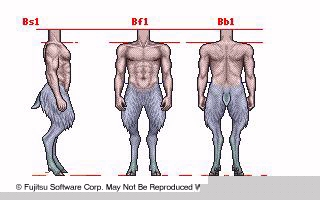
Do you remember this body? I've not seen this anywhere else except for this one picture. It uses the same method you use for describing the parts/positioning to the processor.
Well, no, I don't recognize the body, but it looks like it might be Sheryl Knowles' work. I can imagine it was a proto for fantasy/mythological characters. (BTW - Sheryl Knowles was the Art Dept Manager and Art Director, not just a stable artist. Joe Zona did art primarily. I believe Greg Specht did processing primarily. George Chiu, I think was half & half? Greg did talk to me very briefly at the end of my tenure there about using the Adam/Eve bodies for the adult world, but I don't remember anything much about it. I believe he was working on it evenings.)
Did you have much interaction with Sheryl Knowles? I take it she would’ve been your boss at the time.
Sheryl and I were very good pals for quite a long time. I think the last time I saw her was 2003? I don't really know what has happened to her now; we just gradually fell out of touch. BTW her hubby, Don Woods, helped write Adventure waa-aay back in the old days. I worked with her at Epyx & Electronic Arts as well as Fujitsu. We saw each other socially as well.
A large majority of bodies created post 2000 have been modeled on your work with the Athletic Female/Eve bodies. People use them as guidelines for proportion/texture and such. They tend to draw each frame as a whole, rather than piece them together from parts. Do you remember what you did originally without having a base?
When I did the WorldsAway animations I did the animations as a whole, THEN I broke it up. You cannot get a fluid movement by starting with modular pieces. However, after you've done a couple it's easier to break things up later because you know how it's going to be working. I did the walk cycles first, got those moving, then did other animations (shake hands, wave) based on the parts for the walk cycles. Copying from someone else's work is a time-honored tradition :^) It's just easier. I did spend an amount of time on the Athletic bodies getting the folds/creases in the jeans working correctly, so they looked like -pants-, not spray-on leggings. My artist friends would laugh at me when we were out at lunch because I was studying people walking by...
I spent quite a while getting the walk cycle for Jane/Eve to have just enough hip swing to be mildly sexy, but not so much that it was exaggerated. With those types of resolutions, one or two pixels could make a very noticeable difference in movement. I also made sure to give her some actual flesh movement to add to the realism - her belly moves a bit, and her boobs sway a bit. Tarzan/Adam didn't need quite as much tweaking, but I still tried to get the musculature to flex a bit.
You said you worked for Electric Communities, was that on the EC Habitats/Microcosm project?
Short answer - Yes, Electric Communities was for their on-line stuff. I did establishing animations for the Avatar base ("foundation" model, you might say). I have no idea if any of it was used. The bulk of my art career consisted of projects which never completed or were cancelled before release. WorldsAway is one of the few I worked on which had my artwork in a prominent position.
Do you recall if any of your work at Electric Communities got used?
I really have no knowledge of anything getting used. I did not participate in WorldsAway (I did not have an account or avatar in-world) nor did I participate in EC Habitats. I don't really play video games; never have. I think in some ways it helped my animations because I really wasn't influenced by other people's work, but then again, I wasn't always aware of current looks and potentials. So... two sides of the coin. I was very good at the animations but not the strongest artist in the stable; several artists worked on the backgrounds, objects, and heads, few worked on the animations.
Here’s a couple of screenshots of EC Habitats so you can see if they possibly used some of your work.
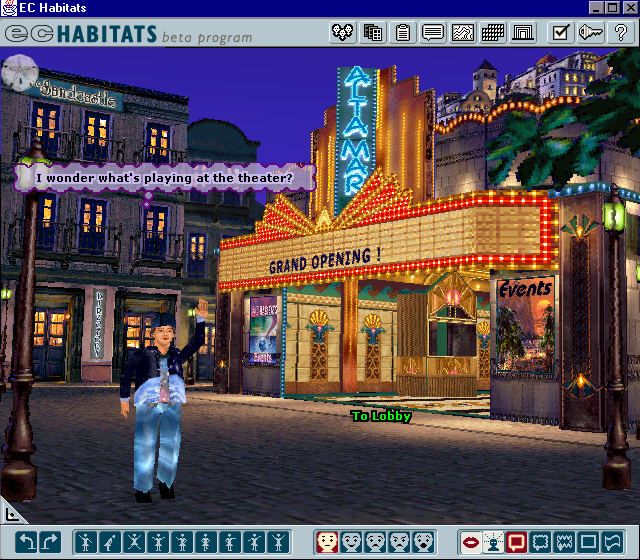
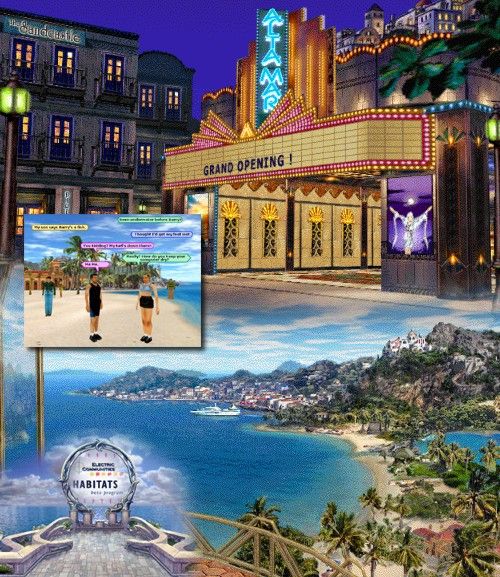
Thanks for the shots of the EC Habitats world. I remember seeing a couple of backgrounds (not these), and they were really quite visually astounding. However, it was just plagued with conceptual issues, and they just couldn't get things off the ground.
There was a significantly large amount of "but we can do better" hampering development.
WorldsAway on the other hand was much more about "Get Something In There!" and then refining later as time/budget allowed, which is why they were successful, even given the strict limitations on memory/color... Electric Communities was trying too hard maybe? I think it was a bit TOO much, if you know what I mean. Management had its issues and developing their own programming language was the least of it.
The screenshots of EC Habitats I shared with you are from a guy named Stu Shepherd. Did you guys ever cross paths at all?
You've certainly been doing your homework! Stu Shepherd and I are buds. I haven't seen him in years, but we're in touch randomly. Did you know his bread-n-butter support has been doing airplane art for Revell models? Yup. All that cool artwork on the front of the box: Stu. He's really good with the spatial stuff. That's an interesting thing about artists - we can usually each punt on something to some degree of success, but we all have particular strengths (mine being animation, for example).
I found these on a site that had scans of an old leaflet Accolade had put out announcing upcoming titles, it turns out Stu Shepherd worked on Fireteam Rogue and obviously you worked on Cybernauts. Can you tell us some more about these games?
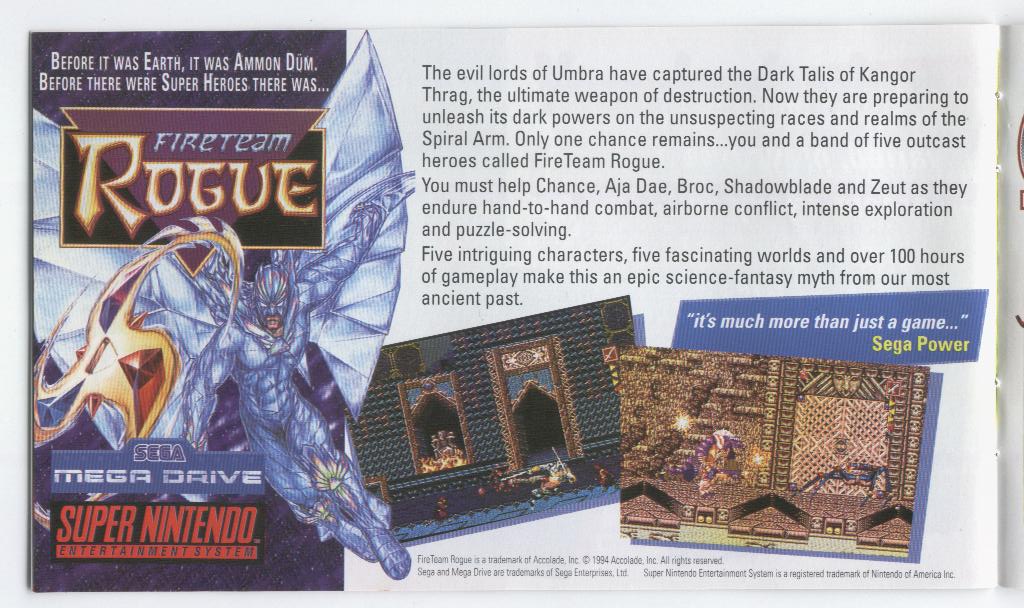
Fireteam Rogue (or FTR) was something that several of my friends were working on. I had an opportunity to do something on it but declined.
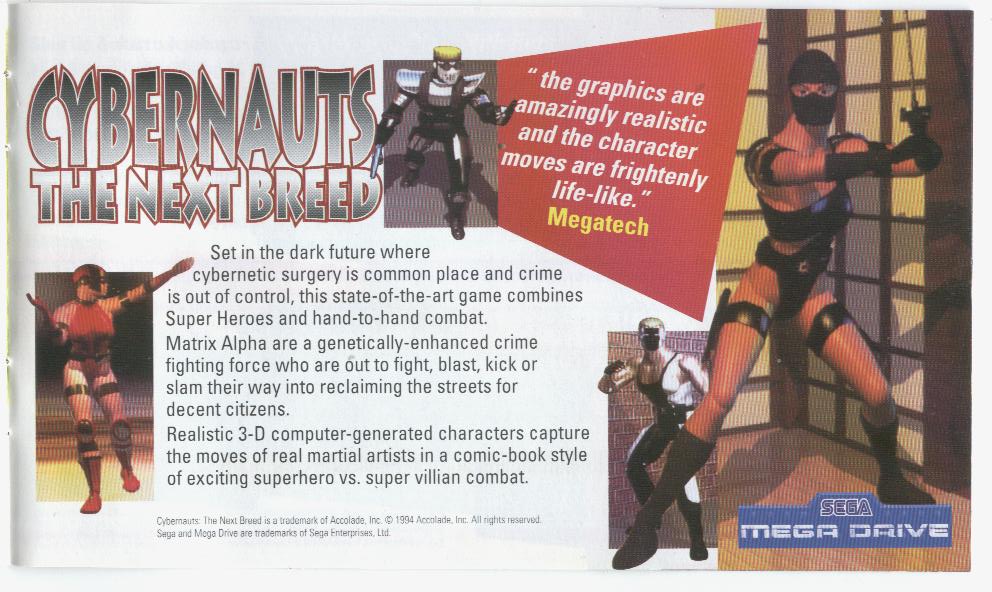
I only vaguely remember working on Cybernauts - it didn't make much of an impression, obviously (as in "oh so unique! "). Actually, what I remember most about Cybernauts is sitting in the corner of my living room at the desk working on it and talking on the phone with a friend. Not the game specifics, but events occurring during the work.

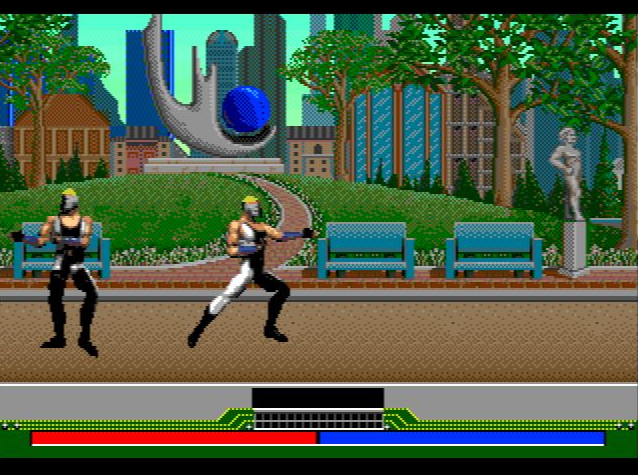
Oh, yeah, Cybernauts would've been done in Animax. PS: Cybernauts park had little squirrels and pigeons sprites in it.
But yes, I worked on console games. Artwork was artwork. Didn't make much difference to me what the display was going to be - desktop or console. Just make sure to follow whatever rules were required for the artwork.
When I worked at Activision I did a set of tiles for a Mah-jongg game. Went to a game store in Phoenix with my brother some time later, saw the box on the shelf, noticed my tile-set was on the back of the box and said 'hey! I did that!' The clerk commented that 'yeah, he'd played that game too' and I tried to convince him that I'd done the ARTWORK for that particular tile set; he didn't believe me. Pfft...
Author notes: In August 2016, we spoke again regarding MetroWorlds.
We re-launched WorldsAway as MetroWorlds. Thanks to you sharing your diskettes with me, it helped get newer artists up to speed with things relating to bodies. Some of them didn't realize how they were originally put together and some really appreciated having the base bits to build with too.
Currently, I'm trying to put together some kind of document to detail what is needed when you draw in the WorldsAway style to help attract freelance artists to join our cause.
It's tough when you've got such a unique style like this with the front on view, centered lighting and larger size than the pixel art people focus on today.
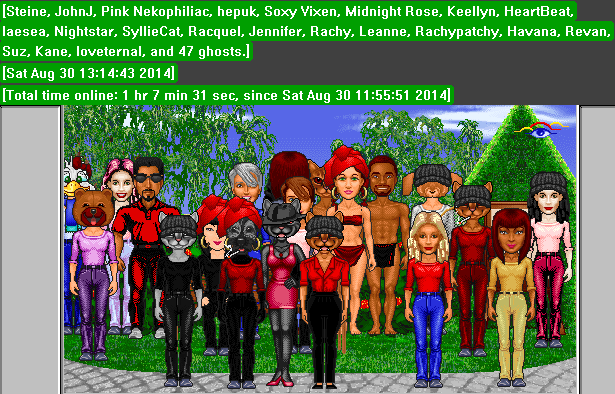
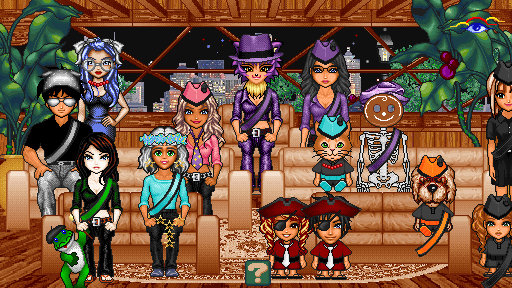
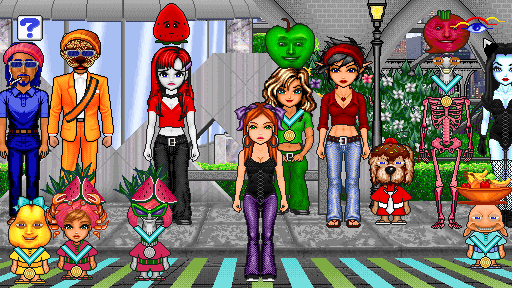
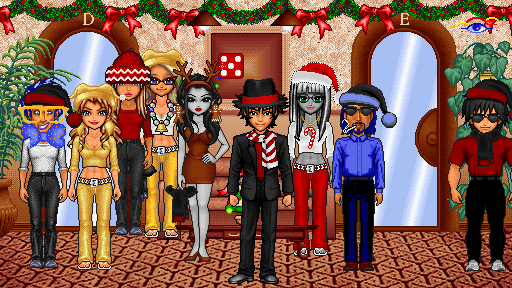
Glad to hear (and see) you have been successful in getting something up and running.
It probably will be a challenge to get artists to rally to your cause; the working parameters were very much different at that time. You mentioned the large size? Well yep, as 640x480 was still the norm, and the art program was D-Paint. With fixed limited palettes, you get the flat shading you see. There really wasn't any way to do smooth contour shading or perspectives.
I'm sure having some of the originals was really helpful for where to break up the figures. It's a lot like making a paper puppet, if you ever did that as a kid.
With all the 'supporting' art, you have a standard issue is "it's not so much fun" to deal with. For us, it was *a job* and there were certain things that just needed doing. Art for the infrastructure, backgrounds, vendables, etc. We all did some of those, and some of the more interesting stuff. Heads were popular fun, smallish, creative, etc. Sometimes the household furnishings were fun. Often there was more of a need for expediency... you'll just have to figure out how to encourage your volunteers to include some of the more mundane bits with their "ooh! Cool!" stuff.
Yeah, we worked with limited sizes and color sets and pixel density was nowhere at what it is today. There were bounding box restrictions for sprites, and different areas of the palette were reserved for different things so buying a spraycan color wouldn't change *everything* in the world. :-)
Thanks for the screenshots! I'd sort of forgotten how violently colorful it all was...
Were you able to make a good living as an artist back in the 90’s and how does it compare to today?
Back in the day, I billed between $30-35/hr for my services. (Keep in mind that contractor rates of taxation are higher, because we're essentially paying our own Social Security dues; I made more money at $33.32/hr because it put me in a lower tax bracket... FYI). Now, making even $30/hr for computer art is *difficult*, because the overseas jobbers will do it for less. Bottom-lining, it means game artists are not really making a living the way they used to.
Also, as we get older, companies are less likely to hire "mature" computer people, wanting the cheaper, and less difficult-to-manage (perception) young hires. The classic thought is that young employees without families will be willing and eager to work 80-hr weeks. Realistically, a 45-yr old with 25 yrs of experience will see the problems long before they arrive, make comments and try to prevent problems, and generally run the project better in the long run, therefore not needing to work 80-hrs. However, this earned experience means they're going to say things that don't make management happy, such as "can't do it like that" or "can't do it by then" or "this is not the best way".
Do you still draw at all?
I'm not doing animations anymore. I do graphics, literature and posters for a small company that makes software for chip design. Technical writing as well. Doing computer graphics NOW is not remotely the same as before. Most of the big game companies are farming out artwork to pools of talent in various foreign countries: Korea was big for a while; then Canada; then Romania. Don't know where the current pool is located. Wherever the art can be done cheapest. That's the crux - cannot make a living US wage doing this type of stuff here, now. Companies don't want to pay the rates we would have to charge, so doing computer-art for a living literally ain't what it used to be.
Do you recall when you made the Oracle dolls for Vaz, Teresias and Uni?
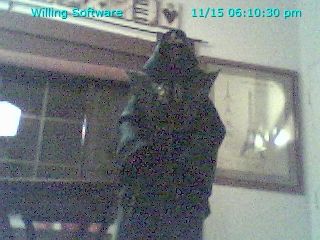
While I don't remember the exact inspiration for the Oracle dolls, I imagine it might have been just some random casual conversation about "Oracle Barbie" maybe, blah blah blah. So whatever it was that sparked the inspiration, I just ran with it. The two male dolls were some sort of cheap Action Figure Dudes I picked up at Toys R Us. I was looking for something that might truly resemble Teresias and/or Vaz. I do remember having to use acetone to remove some sort of "tattoo" designs on the chest and arm. Not certain if the female doll was an actual Barbie (circle r), but something similar, it was the hair color I was looking for (red/auburn).
I spent one night in the floor of my apartment sketching out their designs, and then draping patterns with paper towels (kitchen roll) draping patterns [really good for this type of thing as the paper is malleable, soft, not stiff]. I believe I may have those pencil designs in some ancient sketchbook; if I do find them I'll send you a photo.
Then there was building, out of whatever fabrics worked for the color scheme. Metallic ink pens and etc. to make the costumes. Teresias' doll got glasses from wire, of course; and facial hair. Uni's got a perm, I think. Something I had to do with the hair to make it match hers in real life. I sewed up the costumes, dressed the dolls, and snuck in - maybe on the weekend? - to set them up on their desks. It was a LOT OF FUN!
Q: In closing, do you have any final thoughts on your time at WorldsAway?
Fujitsu WorldsAway was an enjoyable place to work. The Art department was it's own separate little "room", where we kept the lights down and used desk lamps for back lighting. Low - dim - lighting was easier for the concentrated work. The WA team was in essentially a warehouse-type building, in one of the office parks in San Jose. Cubicles were set up in rows. The majority of the programming stuff went on in the middle of the space; the art department was along one side, and there were other offices around the perimeter.
A large portion of the people working on WA were also SCA (Society for Creative Anachronism) members, enough that "Shire Fujitsu" was a loose nickname. There was a great amount of camaraderie. We did see each other socially, quite often. It wasn't unusual for a development group to have an "off-site" once in a while – meaning, they all went off-site to do something fun. It does, actually, help with team-building. For many of these types of projects it's critical to have people working as a team.
The art room was known as a fun place. We were encouraged to express ourselves, bring in toys, books, fun stuff to share, puzzles, inflatables. Fun, play, encourages creativity. And as we were team members, we looked out for each other, and helped one another when we could. There was also commingling with the programmers, too :^) And because of the percentage of SCA people, there was random opportunity for exposure to archaic handicrafts. One of the programmers was very happy to show me his pitch bowl, and explain the procedures for beating out armor. Mary demonstrated spinning with a drop spindle. There was a massage sign up sheet, and you could get a 30-min head/neck/shoulder chair massage done by a professional, in the days before Google!
It was a lot of fun there. Most of the places I worked wound up being fun. Some moreso than others, of course. I opted out of taking a job at EA because when I interviewed, and walked around the place, NOBODY was laughing or even smiling. At a game company? Bad sign. (I did subsequently work there as a contractor.) Not that WA didn't have times of "seriousness' when a milestone was due, etc. But there's a difference between being focused, and being unhappy.